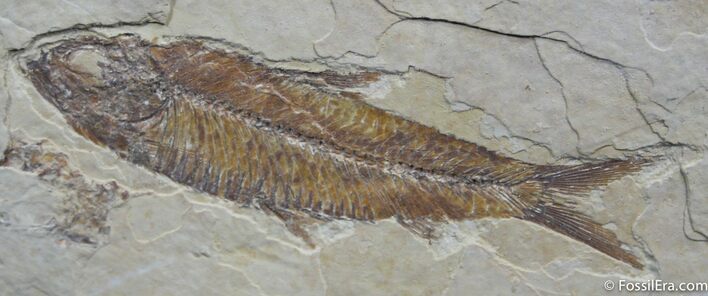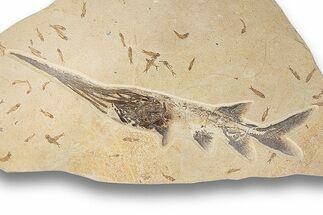This Specimen has been sold.
Google+ Contest Prize: Knightia Fossil Fish
Win This Fossil Fish!
To help celebrate #FossilFriday we are running a series of fossil giveaways on our various social media accounts (Facebook, Twitter, Google+ and Pinterest). This is the prize for today's Google+ contest that will run for 24 hours from noon (PST) on Friday.
To enter go to our Google+ Page, find the contest post, +1 it and leave a comment. After the contest ends we will randomly select a winner and contact them via Google+.
Be sure to +1 our page if you haven't yet as we will be regularly running contests, special offers as well as providing updates on new listings.
Other #FossilFriday Contests
We're running similar contests on Twitter, Facebook and Pinterest concurrently so check them out also.
Trilobite For Twitter
Megalodon Tooth For Facebook
Fossil Ammonite For Pinterest
Now About The Fossil
To help celebrate #FossilFriday we are running a series of fossil giveaways on our various social media accounts (Facebook, Twitter, Google+ and Pinterest). This is the prize for today's Google+ contest that will run for 24 hours from noon (PST) on Friday.
To enter go to our Google+ Page, find the contest post, +1 it and leave a comment. After the contest ends we will randomly select a winner and contact them via Google+.
Be sure to +1 our page if you haven't yet as we will be regularly running contests, special offers as well as providing updates on new listings.
Other #FossilFriday Contests
We're running similar contests on Twitter, Facebook and Pinterest concurrently so check them out also.
Now About The Fossil
About Knightia
Knightia is an extinct genus of schooling, ray-finned, spindle-shaped, bony fish that shares a family with herrings and sardines. They lived in the freshwater (lacustrine) environments of North America and were eaten by just about everything that was bigger. They ate insects and smaller fish, and used gill rakers to feast on plankton. Knightia eocena is the largest of the three species of Knightia, with a typical length of about 15 centimeters. It is the state fossil of Wyoming.
These fish had rows of dorsal and ventral scutes running from the back of the head to the medial fins. They had heavy scales, and small conical teeth. They are popular finds in the Wyoming lagerstätte, and were a primary food source to the large and hungry vertebrates of that once hunted the Green River Formation.
The Green River Formation is an Eocene-aged geologic formation that records the sedimentation in a group of intermountain lakes in three basins along the present-day Green River in Colorado, Wyoming, and Utah. The Eocene spanned approximately 55.8 to 33.8 million years ago. This formation has distinct stratigraphy that displays alternating light and dark layers representing seasonal erosion and deposition.
Freshwater basins, charged by the Uinta Mountains on the Wyoming-Utah border, contained an enormous representation of taxa. The beginning of the Eocene was marked by warm upper latitudes, a greenhouse atmosphere rich in methane and carbon dioxide, and local climates stabilized by large lakes populated by such creatures as crocodiles. Fossil Lake in Wyoming, of which the Green River Formation includes, is known for its well-preserved warm, lacustrine ecology.
The end of the Eocene was dramatically different, with the onset of icehouse climate characteristics, a change in atmospheric chemistry, and possible bolide impacts. The Green River fossils date about 48 million years, but cover several million years, including the transition between the moist early Eocene climate and the slightly drier mid-Eocene.
Knightia is an extinct genus of schooling, ray-finned, spindle-shaped, bony fish that shares a family with herrings and sardines. They lived in the freshwater (lacustrine) environments of North America and were eaten by just about everything that was bigger. They ate insects and smaller fish, and used gill rakers to feast on plankton. Knightia eocena is the largest of the three species of Knightia, with a typical length of about 15 centimeters. It is the state fossil of Wyoming.
These fish had rows of dorsal and ventral scutes running from the back of the head to the medial fins. They had heavy scales, and small conical teeth. They are popular finds in the Wyoming lagerstätte, and were a primary food source to the large and hungry vertebrates of that once hunted the Green River Formation.
The Green River Formation is an Eocene-aged geologic formation that records the sedimentation in a group of intermountain lakes in three basins along the present-day Green River in Colorado, Wyoming, and Utah. The Eocene spanned approximately 55.8 to 33.8 million years ago. This formation has distinct stratigraphy that displays alternating light and dark layers representing seasonal erosion and deposition.
Freshwater basins, charged by the Uinta Mountains on the Wyoming-Utah border, contained an enormous representation of taxa. The beginning of the Eocene was marked by warm upper latitudes, a greenhouse atmosphere rich in methane and carbon dioxide, and local climates stabilized by large lakes populated by such creatures as crocodiles. Fossil Lake in Wyoming, of which the Green River Formation includes, is known for its well-preserved warm, lacustrine ecology.
The end of the Eocene was dramatically different, with the onset of icehouse climate characteristics, a change in atmospheric chemistry, and possible bolide impacts. The Green River fossils date about 48 million years, but cover several million years, including the transition between the moist early Eocene climate and the slightly drier mid-Eocene.
SPECIES
Knightia eocaena
LOCATION
Kemmerer, Wyoming
FORMATION
Green River Formation
SIZE
Largest is 2.8"
CATEGORY
SUB CATEGORY
ITEM
#777
We guarantee the authenticity of all of our specimens.
 Reviews
Reviews












